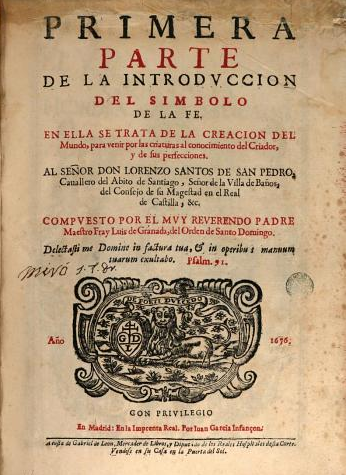
Libraries
Libraries
Introduction of the symbol of faith
The introduction of the symbol of faith is an essential text for the studies of modern Catholicism, especially for those dedicated to asceticism. Encyclopedic work, it summarizes the knowledge proper to Hispanic Christianity that includes the Peninsula and the New World. Nevertheless, it was a book many times criticized:
“The introduction of the Symbol of faith, of Fray Luis de Granada (Salamanca, 1583) […]was, in effect, one the books more mentioned in the minutes of the Inquisition processes” (Vizán, p. 204).
In order to study the particular structure of this work, it is worth to point out the following points outlined by Vizán:
“The Introduction to the Symbol of Faith consists of five parts. The first four were published in 1583 and were left unmentioned in the Index of Books Banned or Expurgated by Quiroga; The fifth came out in 1585. Although Fray Luis de León declares in his dedicatory to Quiroga, among other things, that he does not mention the errors and falsehoods of heretics, since it is convenient to have the common people away from such lies so that they do not fall in them “(Vizán, 206).
“The Introduction to the Symbol of Faith consists of five parts. The first four were published in 1583 and were left unmentioned in the Quiroga Index of books banned or expurgated; The fifth came out in 1585. Nevertheless Fray Luis himself declares, among other things, in the dedication to Quiroga, which does not mention the errors and falsehoods of heretics, since it is convenient to have the common people away from such deceits so that they do not fall In them “(Vizán, pp. 206–207).
Martina Vinatea, in her edition of the Epístola de Amarilis a Belardo (Epistle from Amarilis to Belardo), has pointed out the intertextuality between this American writing and the work in question. In her commentary to Estancia I, she warns that Amarilis takes from the Dominican the definitions and the specialized lexicon. Likewise, it reminds us of the influence that the author had in chroniclers like Guamán Poma de Ayala or in religious like Luis Jerónimo Oré (Vinatea, page 91).

